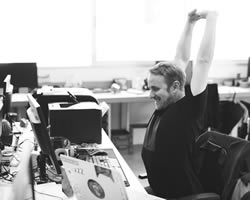Jory Mackay* says we can’t be productive without breaks, but too many of us can’t seem to get away from our desks, even for just a few minutes.
 We’ve all had those days where we get to quitting time and realise we haven’t stood up from our chair for the past four hours.
We’ve all had those days where we get to quitting time and realise we haven’t stood up from our chair for the past four hours.
Breaks are seen as a luxury in our always-on, high-pressure work culture.
Work even invades our meals.
Studies have found that 62 per cent of professionals typically eat lunch at their desks.
We all know we need to take breaks to keep our energy levels high.
So why can’t we seem to take even just a few minutes away from our desks?
A growing body of research has found that “microbreaks” — frequent short breaks taken throughout the day — can be just as or more beneficial than long breaks.
Microbreaks 101
A microbreak is any short break you take from your work during the day.
This could be anything from standing up to stretch to chatting with a co-worker for two minutes or even going to grab a coffee.
Unfortunately, the “anything goes” nature of microbreaks makes them pretty unappealing on the surface.
There are already more than enough distractions pulling at your attention each day.
So why purposefully add more?
However, microbreaks aren’t the same as those other distractions.
Despite its sedentary nature, knowledge work is exhausting both physically and mentally.
Whether you’re an employee or project stakeholder, hours spent sitting at a desk and staring at a screen puts a strain on your eyes, body, and mind.
Even worse, focusing for too long on a task can actually ruin your productivity.
There’s a psychological phenomenon called Troxler Fading, which is when continual attention to a non-moving object can cause it to “disappear” from our view.
However, researchers now believe the same thing can happen when we focus too much on a single task.
While focus is important during the workday, too long spent in a focused state can start to backfire.
Our mind naturally wanders when our energy levels dip.
Our bodies start to crave movement and our attention falters.
Microbreaks impose small interruptions in your focus to ease your body and reboot your brain.
Just a few minutes (or less) of distraction can have a disproportionately powerful impact on your productivity.
Studies show microbreaks can improve your ability to concentrate, reduce workplace stress, increase your happiness about your job, and even help you avoid common desk injuries.
Even better, microbreaks can involve pretty much anything from making a cup of tea to walking around the office.
In fact, there are only two rules you need to follow: they should be short and voluntary.
If you’d like to start working microbreaks into your day but don’t know where to start, here are a few suggestions.
Try the 20/20/20 exercise to reduce eye strain
As we squint or strain to look at our screens, our facial, neck, and shoulder muscles tighten, with eye fatigue becoming a serious issue in as few as two hours.
Microbreaks are a great opportunity to give your eyes a break.
One method that works especially well is the 20/20/20 exercise.
Every 20 minutes, stare at an object at least 20 feet (6 m) away from you for at least 20 seconds.
This simple exercise helps reduce eye fatigue and prevent neck and back soreness, headaches, and blurred vision.
Breathing exercises to lower stress
There are a few quick exercises you can try during a microbreak.
Workplace stress triggers our “fight or flight” response (which brings on elevated anxiety and reduces our cognitive abilities).
To break out of this feeling, you can try a simple breathing technique:
- Sit somewhere comfortable with a straight back.
- Close your eyes and begin breathing through your nose.
- Inhale for a count of two.
- Hold your breath for a count of one.
- Exhale gently through your mouth for a count of four.
- Finish by holding your breath for one second and then repeat.
The key is to exhale longer than you inhale.
Stretch, walk, and move your body to counteract too much sitting
Most of us spend all day sitting in front of a desk, which can lead to all sorts of health issues.
A sedentary lifestyle has been linked to everything from anxiety to hip and back issues and even a higher chance of heart disease.
Microbreaks are a great opportunity to counteract the need to sit during the workday.
Get some fresh air, and be in nature
Spending even just a few minutes during a microbreak outside can boost your cognitive functions and help increase your productivity.
When researchers studied the impact of air quality on productivity, they found poor air circulation in offices led to a drop in productivity of as much as 5–6 per cent.
People who get more fresh air also have reduced mental fatigue and sleep better at night.
Drink more water
Pretty much everyone could be drinking more water during the day.
Being properly hydrated increases your physical performance, keeps you motivated, and improves focus.
In fact, one study found that drinking a glass of water first thing in the morning can increase productivity by 14 per cent.
On the other hand, even mild dehydration can cause fatigue, anxiety, and stress (not to mention trigger headaches and migraines).
Watch a funny video
It might seem counterintuitive to try to boost focus by doing something distracting.
However, even a brief forced mental break can be enough to reboot your thinking.
Spend a few minutes scrolling through Facebook, checking out some cute puppy videos, or jumping on a quick call with a friend.
Researchers from Hiroshima University have even gone so far as to claim that looking at adorable kitten videos “heightens our focus, and the ‘tenderness elicited by cute images’ improves our motor function on the computer”.
Microbreaks are easy to implement, have a huge impact on our productivity, and help us feel energised all day long.
* Jory MacKay is a writer, content marketer and Editor of the RescueTime blog.
This article first appeared at blog.rescuetime.com.











